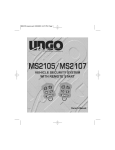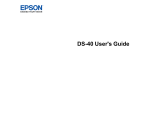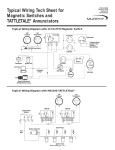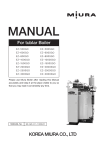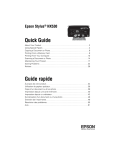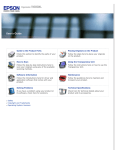Download Clarion MS2100 Installation manual
Transcript
ms2100.qxd 4/29/2003 3:51 PM Page 1
MS2100
VEHICLE SECURITY
SYSTEM
Installation Manual
This vehicle security system requires interfacing with several of the vehicle's
factory wiring harnesses. Be sure to verify all connections with a digital multi-meter
prior to making connections. Failure to do this can result in serious damage to the
vehicles electrical system or deploying an air bag(s). It is also highly recommended
that all connections are soldered, rather than the use of T-Taps or Scotch Locks.
Table of Contents:
1.
2.
3.
4.
5.
6.
7.
8.
9.
10.
11.
12.
13.
14.
15.
16.
17.
18.
19.
20.
21.
22.
23.
24.
25.
Before You Begin . . . . . . . . . . . . . . . . . . . . . . . . . . . . . . . . . . . . . . . . . . 2
After the Installation is Complete . . . . . . . . . . . . . . . . . . . . . . . . . . . . . . 2
System Contents . . . . . . . . . . . . . . . . . . . . . . . . . . . . . . . . . . . . . . . . . . 2
Installation Tips and Suggestions . . . . . . . . . . . . . . . . . . . . . . . . . . . . . . 3
Mounting Components . . . . . . . . . . . . . . . . . . . . . . . . . . . . . . . . . . . . . . 4
Remote Transmitter Layout . . . . . . . . . . . . . . . . . . . . . . . . . . . . . . . . . . 5
Wiring Information . . . . . . . . . . . . . . . . . . . . . . . . . . . . . . . . . . . . . . . . . 6
Starter Disable Interface . . . . . . . . . . . . . . . . . . . . . . . . . . . . . . . . . . . . . 7
Plug-in Connectors . . . . . . . . . . . . . . . . . . . . . . . . . . . . . . . . . . . . . . . . . 7
Programming Remote Transmitters . . . . . . . . . . . . . . . . . . . . . . . . . . . . 8
Arming Mode Selection . . . . . . . . . . . . . . . . . . . . . . . . . . . . . . . . . . . . . 8
System Programmable Parameters . . . . . . . . . . . . . . . . . . . . . . . . . . . . 9
System Test and Shock Sensor Adjustment . . . . . . . . . . . . . . . . . . . . . 11
Parking Light Jumper Settings . . . . . . . . . . . . . . . . . . . . . . . . . . . . . . . 12
Optional Circuit Interrupt . . . . . . . . . . . . . . . . . . . . . . . . . . . . . . . . . . . . 12
Dome Light Supervision Relay Diagram . . . . . . . . . . . . . . . . . . . . . . . . 13
Trunk/Hatch Release Diagram . . . . . . . . . . . . . . . . . . . . . . . . . . . . . . . 14
Door Lock Diagrams . . . . . . . . . . . . . . . . . . . . . . . . . . . . . . . . . . . . . . . 15
Driver’s Door Priority Wiring Diagram . . . . . . . . . . . . . . . . . . . . . . . . . . 20
Horn Honk Wiring Diagram . . . . . . . . . . . . . . . . . . . . . . . . . . . . . . . . . . 23
Status Indicator (LED) Function . . . . . . . . . . . . . . . . . . . . . . . . . . . . . . 24
Siren Chirp Status . . . . . . . . . . . . . . . . . . . . . . . . . . . . . . . . . . . . . . . . 24
Troubleshooting . . . . . . . . . . . . . . . . . . . . . . . . . . . . . . . . . . . . . . . . . . 25
Waranty Information . . . . . . . . . . . . . . . . . . . . . . . . . . . . . . . . . . . . . . . 27
Wiring Diagram . . . . . . . . . . . . . . . . . . . . . . . . . . . . . . . . . . . . . . . . . . 28
ms2100.qxd 4/29/2003 3:51 PM Page 2
1. Before You Begin
• Prior to beginning the installation of the Ungo MS2100, be sure that you have
completely read and understand this installation manual.
• Verify all the vehicle's functions work properly prior to installation (i.e.: power
windows, power door locks, climate controls, radio, etc.)
• Check with the vehicle’s owner on the location of the status LED and valet
switch.
• Protect the vehicle by using fender and seat covers.
• Double-check the location before drilling. Make sure that there are no wire
looms, hoses, or other obstructions. Failure to verify can result in serious
damage to the vehicle.
• Roll down a window(s) before beginning installation, to prevent getting locked
out of the vehicle.
• Set the Polarity Jumper inside the main unit for the Parking Lights.
Warning: Probing wires with a Test Light can result in serious damage to the
vehicle's electrical system and/or deploy air bag system.
2. After The Installation is Complete
• Verify all the vehicle's functions work properly after the installation (i.e.: power
windows, power door locks, climate controls, etc.).
• Test all functions of the vehicle security system and make any changes to the
system parameters if necessary.
3. System Contents
• Main Unit . . . . . . . . . . . . . . . . . . . . . . . . . . . . . . . . . . . .1
• Remote Transmitter . . . . . . . . . . . . . . . . . . . . . . . . . . . .2
• 12-Pin Main Harness . . . . . . . . . . . . . . . . . . . . . . . . . .1
• 2-Pin Status LED Harness . . . . . . . . . . . . . . . . . . . . . . .1
• 2-Pin Valet Switch Harness . . . . . . . . . . . . . . . . . . . . . .1
• 3-Pin Door Lock Harness . . . . . . . . . . . . . . . . . . . . . . .1
• 4-Pin Shock Sensor Harness and Shock Sensor . . . . .1
• 14 Gauge wire with insulated female .250 connectors . .1
• Window Decals . . . . . . . . . . . . . . . . . . . . . . . . . . . . . . .1
• Owner's Manual . . . . . . . . . . . . . . . . . . . . . . . . . . . . . .1
• Installation Manual . . . . . . . . . . . . . . . . . . . . . . . . . . . . .1
-2-
ms2100.qxd 4/29/2003 3:51 PM Page 3
4. Installation Tips and Suggestions
• Use a digital multi-meter to test all wires; DO NOT use a Test Light.
• Check door and trunk pin switches prior to beginning installation. Replace faulty
pin switches with either a factory or a high quality replacement pin switch.
• Good power and ground connections are essential for proper operation of the
security system. Ground the alarm as close to the main unit as possible.
• Route all wires from the engine compartment to the interior of the vehicle
through a grommet using electrical tape and/or split tubing for protection and
camouflaging.
• When adding additional accessories to the security system, such as window
modules, electronic trunk release, etc., be sure to fuse each accessory
independently from the main power source for the security system.
• If extending any wires of the security system is necessary, be sure to use the
same or thicker gauge of wire.
• Never bypass the supplied fuses on the wiring harnesses, as those are
designed to protect the security system and vehicle.
• For maximum security, disguise all the wires under the hood and under the dash
with black tape and/or split tubing.
-3-
ms2100.qxd 4/29/2003 3:51 PM Page 4
5. Mounting Components
5.1 Siren
1. Mount the siren in suitable location under the hood that will not interfere with the
functionality of the vehicle and away from source of extreme heat (i.e.: exhaust
manifold).
2. Make sure the siren cannot be easily accessed from underneath the vehicle or
through the grill.
3. Face the siren facing downwards, so water does not accumulate inside the siren
housing.
4. It is recommended to ground the siren at the same location of the alarm main
unit, not at the siren bracket.
5. Always run wires from under the hood to the cabin area of the vehicle through
the center of a grommet. Running wires along bare metal can cause chaffing
on the wire, leading up to a possible short.
6. Camouflage the siren wires with black tape and/or split tubing.
5.2 Main Unit
1. Mount the main unit high up within the dash, where it requires removing under
dash panels to access the main unit.
2. Make sure the main unit is away from sources of heat, such as the heater core.
3. Verify that none of the wiring for the main unit will get tangled up in the steering
column and/or pedals.
4. Be sure to wire tie the main unit into place to prevent the main unit from being
easily removed or pulled down.
5. Before mounting the main unit, make sure to test all functions of the alarm and
parameter programming has been completed.
5.3 Dual Stage Shock Sensor
1. Mount the shock sensor in the interior of the vehicle, not in the engine
compartment. The shock sensor can be mounted with wire ties or screwed in.
Do not double side tape the shock sensor in place, as the tape will eventually
lose its adhesion.
2. Make sure the shock sensor is away from sources of heat, such as the heater
core.
3. Verify that none of the wiring for the shock sensor will get tangled up in the
steering column and/or pedals.
-4-
ms2100.qxd 4/29/2003 3:51 PM Page 5
5.4 Valet/Override Switch
Prior to drilling the hole for the valet switch, make sure the switch is well hidden and
can't be easily hit. Also, verify there is adequate space behind the valet switch to
accommodate for the depth of the switch.
5.5 Status LED
Mount the status LED so that it is visible from both sides of the vehicle, if possible.
Make sure there is adequate space behind the LED to accommodate for the depth
of the LED.
6. Remote Transmitter Layout
Arm/Lock
Disarm/Unlock
No Function
Auxiliary 1
-5-
ms2100.qxd 4/29/2003 3:51 PM Page 6
7. Wiring Information
7.1 Main 12-Pin Harness
RED: +12V Battery input.
Connect to the vehicle's positive battery terminal and add a fuse within 12 inches.
GREEN: (-) Door trigger input.
Connect to the wire that shows ground when the door is open.*
BLACK: (-) Ground input.
Connect this wire to bare metal, using a lock or star washer to prevent the screw
from coming loose. If possible, use a factory bolt, rather then a screw.
VIOLET: (+) Door trigger input.
Connect to the wire that shows +12V when the door is open.*
YELLOW: +12V ignition input.
Connect to the main ignition wire at the ignition switch. This wire must show +12V
when the ignition is ON and while the vehicle is cranking.
BLUE: (-) Trunk trigger input.
Connect to the wire that shows ground when the trunk/rear hatch is open.
BROWN: (+) Siren output 3A.
Connect to the siren's red wire. Connect the black wire of the siren to (-) chassis
ground. (It is recommended to ground the siren at the same point as the main unit.)
BROWN/WHITE: (-) Horn Honk / Passenger Unlock Output 500mA. (Selectable
Output)
Horn Honk Output: Connect to a relay to pulse the horn when the security system
is triggered. (See Horn Honk Relay Diagrams for assistance.)
Passenger Unlock Output: Connect to a relay to unlock the passenger doors when
the system is configured for Driver's Priority Unlocking. (See Door Lock Diagrams
for assistance.)
BLACK/WHITE: (-) Dome light supervision output 500mA.
Connect to a relay for optional dome light supervision upon disarming the security
system. (See Dome Light Supervision diagram for assistance.)
ORANGE: (-) Armed output 500mA.
This wire provides a ground output when the unit is armed. This wire can be used
to activate an optional circuit interrupt or other device (i.e.: window module, etc).
YELLOW/WHITE: (-) Auxiliary 1 output 500mA.
-6-
ms2100.qxd 4/29/2003 3:51 PM Page 7
Connect to a relay for an optional feature such as a trunk release solenoid,
window module, etc.
WHITE: (+/-) Parking light output (10A relay).
The output polarity of this circuit can be selected for either (+) positive or (-)
negative output via the internal jumper. Make sure to verify the polarity of the
parking light circuit before setting the jumper.
*
Diode isolate the door trigger wires for vehicles with independent door trigger
wires.
7.2 3-Pin Door Lock Harness:
Green: (-) Lock
Red: Not Used
Blue: (-) Unlock
(See Door Lock Diagrams for assistance.)
8. Starter Disable Interface
1. Using a digital multi-meter, determine the wire from the ignition harness that
shows +12V only during crank. Once the wire has been determined, cut the wire
in half and try cranking the vehicle again. The vehicle should be unable to start.
Do not cut the wire to close to the connector or ignition switch, as this will make
it difficult to make the wire connections.
2. Plug the BROWN starter disable wires (with the two female connectors) onto the
males connectors on the alarm main unit. Route the wires from the alarm main
unit to the cut starter wires in the vehicle. Be sure these wires will not interfere
with the operation of the vehicle, including movement of the steering wheel or
pedals. Connect the BROWN wires to each side of the cut starter wire.
3. To verify the connections were made properly, try starting the vehicle. The
vehicle should be able to start up. If not, double check the connection at the
alarm main unit and the vehicle's starter wires.
9. Plug-in Connectors
4-PIN WHITE CONNECTOR: Plug-in connector port for dual stage shock sensor.
3-PIN WHIE CONNECTOR: Plug-in connector port for Door Lock harness.
2-PIN BLUE CONNECTOR: Plug-in connector port for Valet/Override button.
2-PIN RED CONNECTOR: Plug-in connector port for LED indicator.
-7-
ms2100.qxd 4/29/2003 3:51 PM Page 8
10. Programming Remote Transmitters
Prior to programming new remote transmitters to the security system, make sure to
have the desired transmitters ready.
To Enter Remote Transmitter Programming:
1. Turn the ignition ON, OFF, ON, OFF, and leave ON.
2. Press and hold the Valet/Override switch for 5 seconds.
The siren will chirp once.
3. Press the Lock button on the transmitter.
The siren will chirp once.
4. Press the Lock button on the transmitter again.
The siren will chirp twice.
5. Repeat steps 3 and 4 for each additional transmitter.
6. Turn OFF the ignition when transmitter programming is complete.
The siren will chirp 3 times.
11. Arming Mode Selection
1. Turn the ignition On.
2. Press * button on the transmitter until desired Arming Mode is selected:
One Chirp: Passive arming with chirp confirmation.
Two Chirps: Active arming (default setting).
Three Chirps: Passive arming without chirp confirmation.
3. Turn Off the ignition when the Arming Mode selection is complete.
-8-
ms2100.qxd 4/29/2003 3:51 PM Page 9
12. System Programmable Parameters
Feature
Button 1 (default) Button 2
1.
2.
3.
4.
5.
6.
7.
8.
9.
10.
11.
12.
13.
On
On
Single
1 Second
Off
Off
Off
Off
Pulsing
Off
Siren
Horn Output
Normal
Ignition Controlled Door Locking
Ignition Controlled Door Unlocking
Door Unlock Pulse
Door Lock/Unlock Pulse Width
Passive Locking
Door Entry Delay w/ Passive Arming
Ignore Dome Light Delay
Auto Rearm
Horn Honk / Alarming Output
Trunk Disarm Feature
Siren / Horn Chirps
Horn Output / Passenger Unlock
Arming Chirps
Off
Off
Double
3 Seconds
On
On
On
On
Continuous
On
Horn
Passenger Unlock
Silent
12.1 Parameter Descriptions
1. Ignition Controlled Door Locking: Selects whether or not the doors will lock
when the ignition is turned On. Ignition Controlled Door Locks will automatically
lock the doors 10 seconds after the ignition is turned On. To prevent the keys
from being locked inside the vehicle; the security system will not lock the doors
if any of the doors is open when the ignition is turned On.
2. Ignition Controlled Door Unlocking: Selects whether or not the security
system the doors will unlock when the ignition is turned Off. Ignition Controlled
Door Unlocking can be configured to unlock all the doors or driver's door only.
3. Door Unlock Pulse: Selects between single or double door unlock pulse.
4. Door Lock Pulse Width: Selects between a 1-second or 3-second door lock
pulse.
5. Passive Locking: Selects whether or not the door locks will automatically lock
with Auto Rearming and Passive Arming.
6. Door Entry Delay with Passive Arming: Selects whether or not the door
trigger input will be delayed for 15 seconds, allowing access to the Override
switch. The door trigger is delayed only when the system arms passively.
-9-
ms2100.qxd 4/29/2003 3:51 PM Page 10
7. Ignore Dome Light Delay: Selects whether or not the security system will
ignore the door trigger for 20 seconds upon arming. For vehicles with timed
dome light delays, the system will not detect a faulty door trigger upon arming.
8. Auto Rearming: Selects whether or not the security system will rearm if no
activity is detected after Remote Disarming. (If Passive Door Locking feature
was selected during installation, the system will also relock the doors.)
Automatic Rearming only takes place if the system was Armed (actively or
passively) for at least 10 seconds and then remotely disarmed.
9. Horn Honk / Alarming Output: Selects whether the Brown/White wire will
pulse or be continuous when the alarm is sounding. In continuous mode, it can
be used to trigger an interior siren (a pain generator). (Parameter 12 must be
set at default mode: Horn Output)
10. Trunk Disarm Feature: This feature will automatically disarm the security
system when Auxiliary 1 is activated.
11. Siren or Horn Chirps: Selects between siren chirps or horn chirps.
12. Horn Output / Passenger Unlock: Selects whether the Brown/White wire is
going to be used to pulse the horn or Passenger Unlock operation.
13. Arming Chirps: Selects whether or not the security system will chirp when arm
and disarmed.
12.2 Entering Parameter Programming
1. Turn the ignition ON.
2. Within 5 seconds, press the Valet/Override button 5 times.
The siren will chirp, indicating that User Programming has been entered.
3. Press the Valet/Override button the number of times equal to the Parameter to
be changed.
The siren will chirp each time the Valet/Override is pressed.
4. Within 5 seconds, press the transmitter button corresponding to the desired
operating mode that Parameter.
The siren will chirp corresponding to the button depressed.
5. When finished, turn the ignition OFF to save changes.
12.3 Default Reset for Parameter Programming
1. Turn the ignition ON.
2. Within 5 seconds, press the Valet/Override button 5 times.
-10-
ms2100.qxd 4/29/2003 3:51 PM Page 11
The siren will chirp, indicating that Programming has been entered.
3. Press transmitter button 3.
The siren will chirp 6 times indicating the reset signal has been received, and
Parameters have been reset to factory default.
13. System Test and Shock Sensor Adjustment
13.1 System Test
1. Verify the Programmable Parameters are set.
2. Verify all wire connections are correct and secure.
3. Make sure none of the wires for the security system will interfere with safe
operation of the vehicle.
4. Test all functions of the vehicle, i.e. power door locks, power windows, lights,
etc.
5. Arm the security system; checking the siren chirps, parking lights, LED, and
door locks.
6. Disarm the security system; checking the siren chirps, parking lights, LED, door
locks, and dome light supervision.
7. Test all the entry points of the vehicle, doors, hood, and trunk/hatch. (Be sure
to test all doors.)
13.2 Dual Stage Shock Sensor Test
1. Turn the ignition On.
2. Within 4 seconds, press Button 1 (Lock button).
3. Test the sensitivity of the sensor by hitting various locations on the vehicle. (Do
hit the windshield or any other window. Be careful not to dent or damage any
parts of the vehicle during shock sensor testing.)
The siren will chirp when a trigger impact is detected.
4. To make shock sensor adjustments:
Turn the adjustment screw on the shock sensor clockwise to increase the
sensitivity.
Turn the adjustment screw on the shock sensor counter clockwise to
decrease the sensitivity.
5. Turn the ignition Off when the desired sensitivity level is reached.
-11-
ms2100.qxd 4/29/2003 3:51 PM Page 12
14. Parking Light Jumper Settings
The Parking Light Polarity Jumper selects the polarity (+/-) for the output of the
on-board Parking Light relay.
Negative
Positive
15. Optional Circuit Interrupt
-12-
ms2100.qxd 4/29/2003 3:51 PM Page 13
16. Dome Light Supervision Relay Diagrams
Negative Door Pinswitch
Positive Door Pinswitch
-13-
ms2100.qxd 4/29/2003 3:51 PM Page 14
17. Trunk/Hatch Release Diagrams
Negative Trunk Release Wire
Positive Trunk Release Wire
-14-
ms2100.qxd 4/29/2003 3:51 PM Page 15
18. Door Lock Diagrams
Negative Door Lock System
-15-
ms2100.qxd 4/29/2003 3:51 PM Page 16
Positive Door Lock System
-16-
ms2100.qxd 4/29/2003 3:51 PM Page 17
Reverse Polarity Door Lock System
-17-
ms2100.qxd 4/29/2003 3:51 PM Page 18
Actuator Diagram
-18-
ms2100.qxd 4/29/2003 3:51 PM Page 19
Vacuum Pump System
-19-
ms2100.qxd 4/29/2003 3:51 PM Page 20
19. Driver’s Door Priority Wiring Diagram
Negative Door Lock System with Driver’s Door Priority
-20-
ms2100.qxd 4/29/2003 3:51 PM Page 21
Positive Door Lock System with Driver’s Door Priority
-21-
ms2100.qxd 4/29/2003 3:51 PM Page 22
Reverse Polarity Door Lock System with Driver’s Door Priority
-22-
ms2100.qxd 4/29/2003 3:51 PM Page 23
20. Horn Honk Wiring Diagrams
Negative Horn Trigger
Positive Horn Trigger
-23-
ms2100.qxd 4/29/2003 3:51 PM Page 24
21. Status Indicator (LED) Functions
LED STATUS
FUNCTION
Off
Slow Flash
Rapid Flash
Rapid Flash (after disarm)
On Solid
On Solid (after arming)
System is disarmed in Active mode.
System is Armed.
Passive arming indication and auto rearm.
System was triggered.
Valet mode.
On for 3 seconds, shock sensor trigger
has been bypassed.
Door or hood/trunk is open.
On Solid (when disarmed
and not in Valet mode)
22. Siren Chirp Status
CHIRPS
1 Chirp
2 Chirps
3 Chirps
4 Chirps
5 Rapid Chirps
FUNCTION
System Armed
System Disarmed
System Disarmed, but alarm triggered while away.
10 seconds after arming indicates
defective sensor or trigger zone.
Warn away triggered.
-24-
ms2100.qxd 4/29/2003 3:51 PM Page 25
23. Troubleshooting
Symptom
Probable Cause
Suggested Correction
Alarm doesn't Arm/Disarm.
Alarm in Valet Mode.
Ignition input has voltage
on it. Missing +12 or
ground.
Take alarm out of Valet
mode. Turn key off and
verify yellow wire is
connected to correct
ignition wire. Check +12V
and ground connections.
Alarm will not Passively
Arm.
Passive arming is
programmed Off. Wrong
door switch polarity. Alarm
in Valet mode.
Change arming mode to
Passive arming. Change
ignition input. Make sure
alarm is not in Valet.
Alarm will not enter
Remote programming
mode.
Ignition was not left in the
On position after turning it
On & Off three times.
Sequence not performed
rapidly enough.
Valet/Override switch is not
plugged in or defective.
Alarm is armed.
Repeat procedure quicker.
Check connection on Valet
button. Make sure the
alarm is not in Valet or
Armed.
Alarm chirps 4 times 10
seconds after the system is
Armed.
Factory Dome light delay is
longer than 10 seconds.
Door switch or sensor is
defective.
Set parameter for Ignore
Dome Light Delay to On.
Adjust or replace shock
sensor.
Parking lights do not flash.
Wrong wire connected to
the White wire. Polarity
selection needs to be
changed.
Correct the connection to
the parking light wire.
Move the jumper next to
relay on board to correct
polarity (+/-).
System Arms and Disarms,
but doesn't chirp the siren.
Arming Chirps has been
set to " Silent."
Set parameter for Arming
Chirp to "Normal."
-25-
ms2100.qxd 4/29/2003 3:51 PM Page 26
Symptom
Probable Cause
Suggested Correction
Dome light supervision
does not activate upon
Disarm.
Relay wired incorrectly.
See Dome Light
Supervision diagrams.
Poor range with the
remotes.
Antenna wire is grounded;
Module is picking up
interference from the
vehicle's electrical system.
Make sure the antenna is
not connected to ground.
Relocate module or route
antenna away from
computer modules.
Vehicle starts when the
alarm is Armed.
Wrong starter wire is cut.
Locate the proper starter
wire and reconnect the
other wire.
Vehicle will not start when
the alarm is Disarmed.
Bad connection on Brown
wire. Defective starter
defeat relay.
Repair connection at
starter wire. Replace
module.
Keyless entry does not
operate with remote.
Wrong door lock polarity.
Wrong door lock wires are
connected.
See Door Lock Diagrams.
Verify the vehicle's door
lock wires.
Ignition controlled door lock
feature does not operate.
Ignition wire shows +12V at
all times. Door is open.
Door trigger input wrong
polarity.
Connect to correct ignition
wire. Close door. Change
door trigger polarity.
Vehicle's horn honks when
the alarm is Disarmed and
door is opened.
Vehicle factory security
system needs to be
disarmed.
Locate the factory disarm
wire and use the door
Unlock pulse to disarm the
factory alarm.
Alarm system intermittently
works.
Bad power and/or ground
connections.
Replace and secure power
and ground connections.
Vehicle will not start and
alarm does not function
properly.
Vehicle battery is dead or
drops below 7.5V when
trying to start the vehicle.
Replace or charge battery.
-26-
ms2100.qxd 4/29/2003 3:51 PM Page 27
24. Warranty Information
This Ungo Security System is warranted against defects in material and workmanship. The main unit
and remote controls are covered by this limited lifetime warranty. This Limited Lifetime Warranty applies
to Ungo Security systems that have been installed by an authorized Ungo Security dealer. This warranty
is to the Original Purchaser ("Owner") and to the original vehicle in which it was installed into. This
warranty is not transferable to any subsequent owner(s) of the product(s).
Warranty Program:
Main Unit
Remote Controls
Siren
Shock Sensor
LED
Valet/Override Button
Limited Lifetime
Limited Lifetime
One year from date
One year from date
One year from date
One year from date
of
of
of
of
purchase
purchase
purchase
purchase
The Warranty does not cover batteries or products deemed damage through alterations or installation. It
also does not cover products mishandled, misused, neglected, abused, water damaged, or with
removed/altered serial numbers.
PROOF OF PURCHASE WILL BE REQUIRED FOR WARRANTY SERVICE OF THIS PRODUCT.
This warranty does not cover the costs incurred for removal or reinstallation of the main unit and/or any
damage to the vehicle or the vehicle's electrical system.
The sole responsibility of Clarion Corporation under this Warranty shall be limited to the repair or
replacement of the product, at the sole discretion of Clarion Corporation.
If it becomes necessary to send the product or any defective part to Clarion Corporation, the product
must be shipped in its original carton or equivalent carton, fully insured, with shipping charges prepaid.
Clarion Corporation will not assume any responsibility for any loss or damage incurred in shipping.
ALL IMPLIED WARRANTIES EXCEPT TO THE EXTENT PROHIBITED BY APPLICABLE LAW SHALL
HAVE NO GREATER DURATION THAN THE WARRANTY PERIOD SET FORTH ABOVE. UNDER NO
CIRCUMSTANCES SHALL CLARION CORPORATION BE LIABLE FOR ANY LOSS OR DAMAGE,
DIRECT OR CONSEQUENTIAL, ARISING OUT OF THE USE OR INABILITY TO USE OF THE
PRODUCT. BECAUSE SOME STATES DO NOT ALLOW LIMITATIONS ON HOW LONG AN IMPLIED
WARRANTY LASTS OR EXCLUSIONS OR LIMITATIONS OF INCIDENTIAL OR CONSEQUENTIAL
DAMAGES, THE ABOVE LIMITATIONS OR EXCLUSIONS MAY NOT APPLY TO YOU.
THIS WARRANTY GIVES YOU SPECIFIC LEGAL RIGHTS, AND YOU MAY ALSO HAVE THE OTHER
RIGHTS, WHICH VARY FROM STATE TO STATE.
Should you have any difficulties with the performance of this product during warranty, please call: 1-800GO-CLARION or visit your local Ungo dealer. You may also contact the National Service Manager at the
following address below for additional service help you may need.
Clarion Corporation of America
Attn: National Service Manager
661 W. Redondo Beach Blvd.
Gardena, Ca 90247
-27-
ms2100.qxd 4/29/2003 3:51 PM Page 28
25. Wiring Diagram
97-MS2100-00 Rev. 1 (4/03)
































